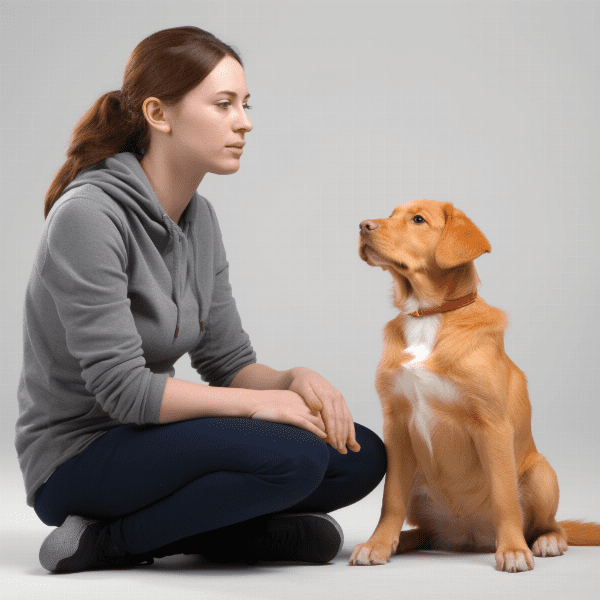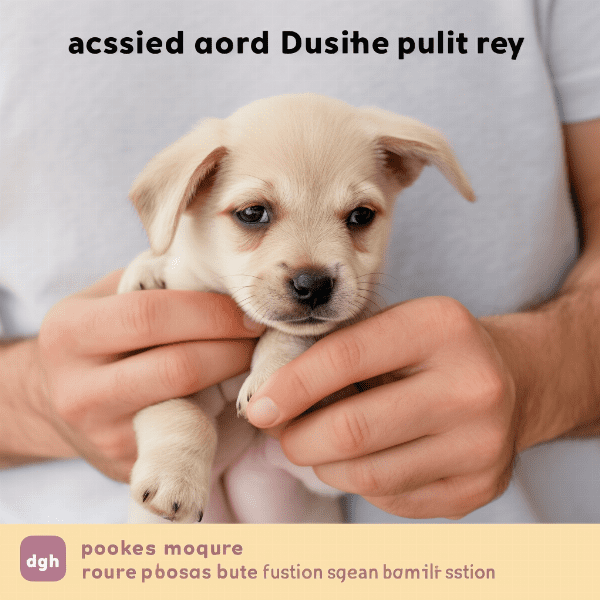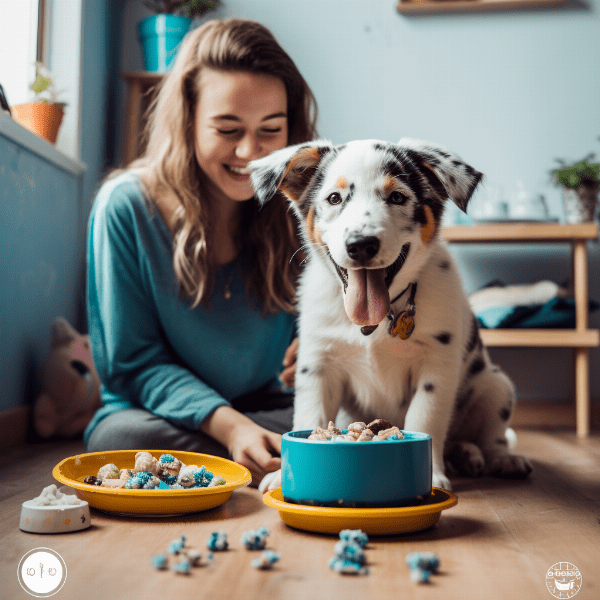Table of Contents
- Understanding the Reasons Behind the Aggressive Biting
- Redirecting Your Puppy’s Biting onto Appropriate Toys
- Consistency in Training and Reinforcement
- Using Positive Reinforcement Techniques to Promote Good Behavior
- Incorporating Regular Exercise and Playtime to Reduce Aggression
- Teaching Bite Inhibition to Reduce the Intensity of Biting
- Addressing Any Underlying Medical Issues that May Be Contributing to the Aggressive Behavior
- Seeking Professional Help from a Certified Dog Trainer or Behaviorist
- Managing Your Puppy’s Environment to Prevent Triggers for Aggressive Biting
- Staying Patient and Persistent in Your Efforts to Correct the Behavior
Understanding the Reasons Behind the Aggressive Biting
As a new puppy owner, it can be alarming and distressing to have your 4-month-old puppy exhibit aggressive biting behavior. However, it’s important to understand that this behavior is not uncommon, and there are reasons why your puppy may be biting.
Normal Puppy Behavior
It’s important to keep in mind that biting is a normal part of a puppy’s development. Puppies explore the world with their mouths, and they use their teeth to learn about their environment. Biting and mouthing are also natural ways that puppies play with each other.
Teething
Puppies begin to lose their baby teeth and grow their adult teeth around 4 months of age. This process can be uncomfortable and painful, and your puppy may be biting as a way to alleviate the discomfort.
Lack of Socialization
If your puppy wasn’t properly socialized during the critical socialization period (between 3 and 14 weeks of age), they may not have learned appropriate bite inhibition. This can lead to rough play and aggressive biting behavior.
Fear or Anxiety
If your puppy feels threatened or scared, they may resort to aggressive biting behavior as a way to protect themselves. It’s important to identify the triggers for your puppy’s fear or anxiety and work to address them.
Frustration or Over-Stimulation
Puppies have a lot of energy and can become over-stimulated easily. If your puppy is biting aggressively, it may be a sign that they’re feeling frustrated or overwhelmed.
Understanding the reasons behind your puppy’s aggressive biting behavior is the first step in addressing and correcting the behavior. By identifying the underlying cause, you can take steps to redirect your puppy’s behavior and encourage positive interactions.
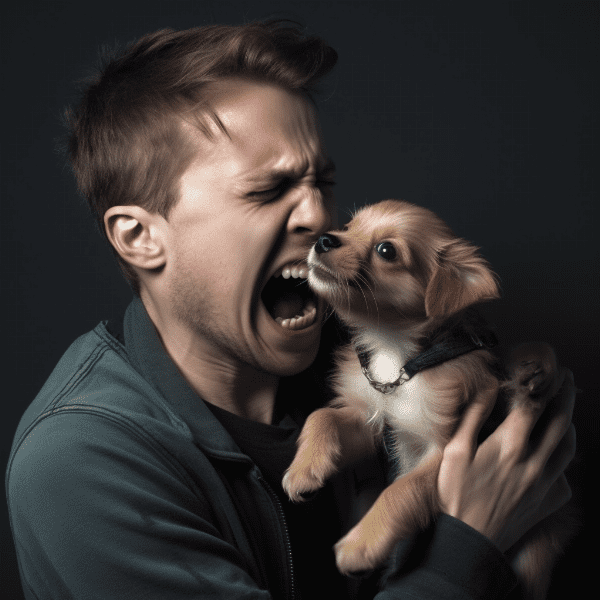
Redirecting Your Puppy’s Biting onto Appropriate Toys
Once you understand the reasons behind your puppy’s aggressive biting behavior, it’s time to start redirecting their behavior onto appropriate toys. This will not only protect you and others from painful bites but also help your puppy learn what is acceptable to bite and what is not.
Provide Plenty of Chew Toys
One of the best ways to redirect your puppy’s biting behavior is to provide them with plenty of chew toys. Choose toys that are durable and safe for your puppy to chew on. You can also freeze some of the toys to provide relief for your puppy’s teething pain.
Use Toys as Rewards
Use toys as a reward for good behavior. When your puppy is playing with their toys and not biting, give them plenty of praise and reward them with a treat. This will reinforce positive behavior and help your puppy understand what is acceptable.
Avoid Rough Play
Avoid rough play, such as tug-of-war or wrestling, as this can encourage aggressive biting behavior. Instead, use interactive toys such as balls or frisbees to play with your puppy. This will help them burn off excess energy and provide a positive outlet for their natural playfulness.
.
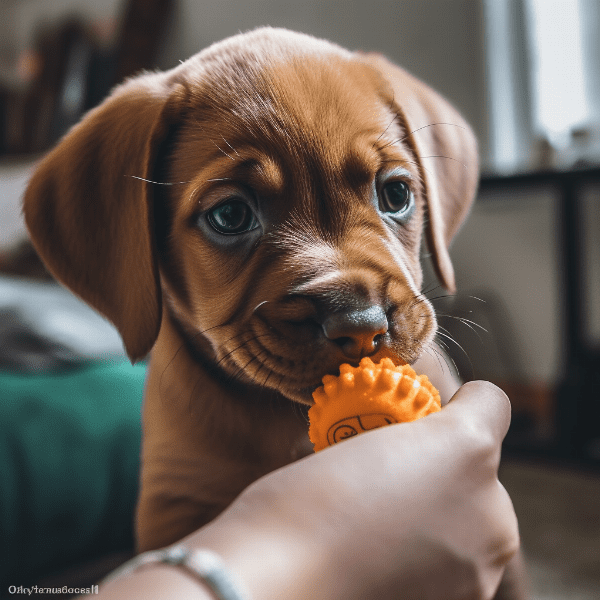
Consistency in Training and Reinforcement
Consistency in training and reinforcement is crucial when it comes to correcting your 4-month-old puppy’s aggressive biting behavior. This means setting clear boundaries and expectations and consistently reinforcing positive behavior.
Establish Clear Boundaries
Establishing clear boundaries is important when training your puppy. Decide what is acceptable behavior and what is not, and communicate this to your puppy consistently. For example, if your puppy bites, firmly say “no” and redirect their attention to an appropriate toy.
Avoid Punishment
Avoid punishing your puppy for aggressive biting behavior. Punishment can actually make the behavior worse and may lead to fear or anxiety in your puppy. Instead, focus on redirecting your puppy’s behavior and rewarding positive behavior.
Involve Everyone in the Household
Consistency in training and reinforcement requires the involvement of everyone in the household. Make sure that everyone is on the same page when it comes to training your puppy and establishing clear boundaries. This will prevent confusion and help reinforce positive behavior.
Consistency in training and reinforcement is essential when correcting your puppy’s aggressive biting behavior. By establishing clear boundaries, using positive reinforcement, avoiding punishment, being patient, and involving everyone in the household, you can promote positive behavior and create a well-behaved and happy puppy.
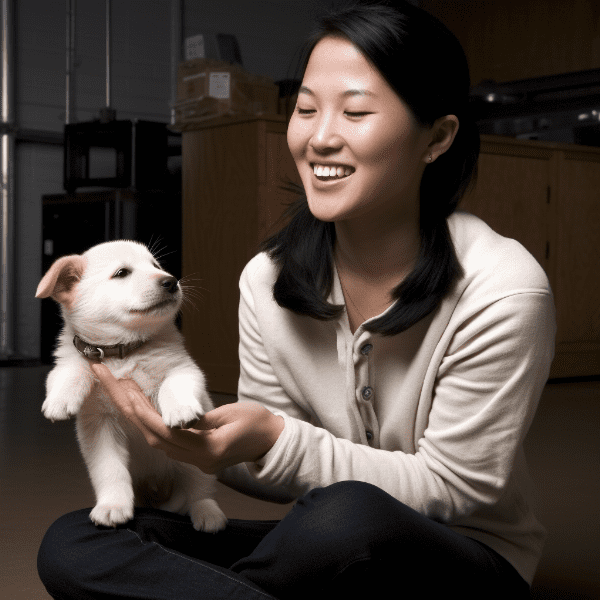
Using Positive Reinforcement Techniques to Promote Good Behavior
Positive reinforcement is a powerful tool for promoting good behavior in your 4-month-old puppy. It involves rewarding your puppy for good behavior, rather than punishing them for bad behavior. This creates a positive learning environment and helps your puppy understand what is expected of them.
Identify Desired Behaviors
The first step in using positive reinforcement is identifying the behaviors you want to promote in your puppy. For example, you may want to encourage your puppy to play with their toys instead of biting your hands. Once you’ve identified the desired behavior, you can begin to reward your puppy when they exhibit that behavior.
Use Treats and Verbal Praise
Treats and verbal praise are effective forms of positive reinforcement. When your puppy exhibits the desired behavior, reward them with a small treat and plenty of verbal praise. This will help your puppy understand that the behavior is good and encourage them to repeat it in the future.
Timing is Important
Timing is important when using positive reinforcement. You want to reward your puppy immediately after they exhibit the desired behavior, so they understand what they’re being rewarded for. If you wait too long, your puppy may not make the connection between the behavior and the reward.
Use a Clicker
Clicker training is a popular form of positive reinforcement that involves using a clicker to mark the desired behavior. When your puppy exhibits the desired behavior, you click the clicker and immediately reward them. This helps your puppy understand what behavior is being rewarded and reinforces the behavior.
Using positive reinforcement techniques is an effective way to promote good behavior in your 4-month-old puppy. By identifying desired behaviors, using treats and verbal praise, being consistent, timing rewards properly, and using a clicker, you can create a positive learning environment for your puppy and encourage positive behavior.
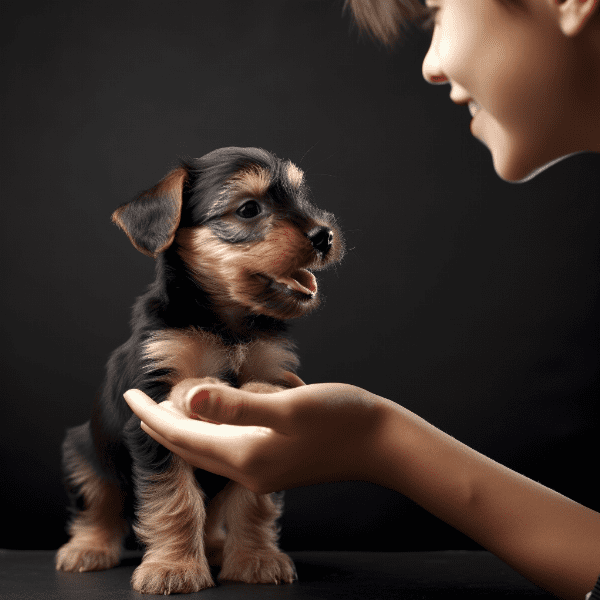
Incorporating Regular Exercise and Playtime to Reduce Aggression
Regular exercise and playtime are essential for reducing aggression in your 4-month-old puppy. Puppies have a lot of energy, and if they don’t have an outlet for that energy, they may resort to aggressive biting behavior. Here are some tips for incorporating regular exercise and playtime into your puppy’s routine.
Provide Adequate Exercise
Provide your puppy with adequate exercise on a daily basis. This can include walks, playtime in the backyard, or a game of fetch. The amount of exercise your puppy needs will depend on their breed and energy level, but as a general rule, aim for at least 30 minutes of exercise per day.
Use Interactive Toys
Interactive toys, such as puzzle toys or toys that dispense treats, are a great way to provide mental stimulation and exercise for your puppy. These toys can keep your puppy occupied for extended periods of time and prevent them from resorting to aggressive biting behavior out of boredom.
Incorporate Training into Playtime
Incorporating training into playtime can be a great way to provide exercise and mental stimulation for your puppy. For example, you can use playtime to work on obedience training or teach your puppy new tricks. This can be a fun and rewarding way to bond with your puppy while promoting good behavior.
Set a Regular Routine
Setting a regular routine for exercise and playtime can help your puppy know what to expect and reduce anxiety and frustration. Try to stick to a regular schedule for walks, playtime, and training sessions. This can also help prevent over-stimulation, which can lead to aggressive biting behavior.
Supervise Playtime
Supervising playtime is important to ensure that your puppy is playing safely and not resorting to aggressive behavior. If your puppy becomes too rough during play, redirect their attention to an appropriate toy or end the play session altogether.
Incorporating regular exercise and playtime into your puppy’s routine is essential for reducing aggression and promoting good behavior. By providing adequate exercise, using interactive toys, incorporating training into playtime, setting a regular routine, and supervising playtime, you can create a happy and healthy environment for your puppy.
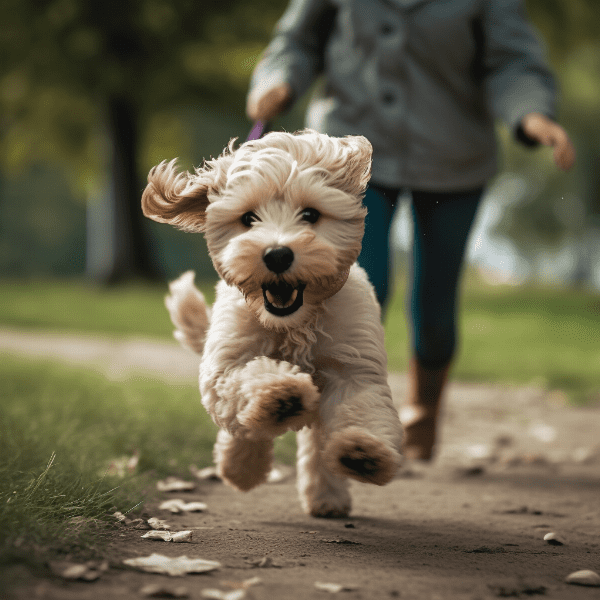
Teaching Bite Inhibition to Reduce the Intensity of Biting
Teaching bite inhibition is an important step in reducing the intensity of your 4-month-old puppy’s biting behavior. Bite inhibition is the ability of a dog to control the force of their bite, which can help prevent serious injury if they do bite. Here are some tips for teaching bite inhibition to your puppy.
Start with Gentle Play
Start with gentle play to help your puppy understand that biting hard is not acceptable. Use soft toys or your hands to play with your puppy, and when they bite too hard, say “ouch” and stop playing. This will help your puppy understand that biting too hard causes the play to stop.
Use Positive Reinforcement
Use positive reinforcement to reward your puppy for exhibiting gentle play behavior. When your puppy plays gently or stops biting when you say “ouch,” reward them with treats or verbal praise. This will help your puppy understand that gentle play is the behavior that is rewarded.
Increase the Pressure Gradually
Once your puppy understands that gentle play is rewarded, you can begin to increase the pressure gradually. Allow your puppy to bite a little harder and then say “ouch” and stop playing if they bite too hard. This will help your puppy learn to control the force of their bite.
Be Consistent
Consistency is important when teaching bite inhibition. Be consistent in your reactions to your puppy’s biting behavior, and always reward gentle play. This will help your puppy understand what is expected of them and promote positive behavior.
Seek Professional Help if Needed
If your puppy’s biting behavior is severe or doesn’t improve with training, seek professional help from a certified dog trainer or behaviorist. They can provide additional guidance and support to help your puppy learn bite inhibition and reduce the intensity of their biting behavior.
Teaching bite inhibition is an important step in reducing the intensity of your puppy’s biting behavior. By starting with gentle play, using positive reinforcement, increasing pressure gradually, being consistent, and seeking professional help if needed, you can help your puppy develop the ability to control the force of their bite and promote positive behavior.

Addressing Any Underlying Medical Issues that May Be Contributing to the Aggressive Behavior
In some cases, aggressive biting behavior in a 4-month-old puppy may be caused by underlying medical issues. It’s important to address any potential medical issues that may be contributing to your puppy’s behavior to ensure their overall health and well-being.
Visit a Veterinarian
The first step in addressing any potential medical issues is to visit a veterinarian. They can perform a thorough physical examination and identify any underlying medical issues that may be contributing to your puppy’s aggressive biting behavior. This may include dental issues, ear infections, or other medical conditions.
Address Medical Issues Promptly
If your veterinarian identifies any medical issues, it’s important to address them promptly. Delaying treatment can lead to increased pain or discomfort for your puppy, which can exacerbate aggressive behavior.
Consider Spaying or Neutering
Spaying or neutering your puppy may also help reduce aggressive behavior. This can help regulate hormones and reduce the likelihood of territorial or dominant behavior.
Evaluate Medication Side Effects
If your puppy is taking medication for a medical condition, it’s important to evaluate the potential side effects of the medication. Some medications may cause increased aggression in some dogs, and adjusting the medication or dosage may be necessary.
Seek Professional Help
If medical issues are ruled out, but your puppy’s aggressive biting behavior continues, seek professional help from a certified dog trainer or behaviorist. They can help identify any underlying behavioral issues and provide guidance and support to help correct the behavior.
Addressing any underlying medical issues that may be contributing to your puppy’s aggressive biting behavior is important for their overall health and well-being. By visiting a veterinarian, addressing medical issues promptly, considering spaying or neutering, evaluating medication side effects, and seeking professional help if needed, you can ensure that your puppy receives the appropriate care and treatment to correct their behavior.

Seeking Professional Help from a Certified Dog Trainer or Behaviorist
If your 4-month-old puppy’s aggressive biting behavior persists despite your efforts to correct it, seeking professional help from a certified dog trainer or behaviorist may be necessary. These professionals have the knowledge and expertise to identify underlying behavioral issues and develop a personalized training plan for your puppy.
Credentials and Experience
When seeking professional help, it’s important to choose a certified dog trainer or behaviorist with the appropriate credentials and experience. Look for someone who has completed certification programs from reputable organizations, such as the Certification Council for Professional Dog Trainers (CCPDT) or the International Association of Animal Behavior Consultants (IAABC).
Initial Consultation
An initial consultation with a certified dog trainer or behaviorist is important to assess your puppy’s behavior and identify any underlying issues. During this consultation, the trainer or behaviorist will observe your puppy’s behavior and discuss any previous training methods you’ve used.
Personalized Training Plan
A certified dog trainer or behaviorist will develop a personalized training plan for your puppy based on their observations and assessment. This plan will address specific behavior issues and include training exercises to promote positive behavior.
Ongoing Support
Ongoing support is an important part of the training process. A certified dog trainer or behaviorist will provide guidance and support throughout the training process to help you and your puppy achieve your goals. They may also offer follow-up sessions or group classes to reinforce positive behavior.
Commitment and Consistency
Achieving positive behavior in your puppy requires commitment and consistency from both you and your trainer. It’s important to follow the training plan and be consistent in your approach to training. With dedication and persistence, you can help your puppy overcome their aggressive biting behavior and become a well-behaved and happy member of your family.
Seeking professional help from a certified dog trainer or behaviorist is an effective way to address persistent aggressive biting behavior in your 4-month-old puppy. By choosing a qualified trainer, participating in an initial consultation, receiving a personalized training plan, receiving ongoing support, and committing to the process, you can help your puppy achieve positive behavior and create a strong bond between you and your furry companion.
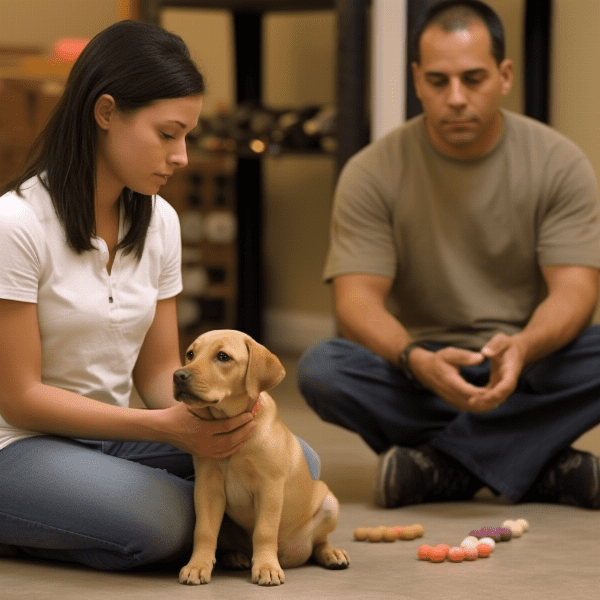
Managing Your Puppy’s Environment to Prevent Triggers for Aggressive Biting
Managing your 4-month-old puppy’s environment is an important step in preventing triggers for aggressive biting behavior. By creating a safe and positive environment, you can reduce the likelihood of your puppy engaging in aggressive behavior. Here are some tips for managing your puppy’s environment.
Puppy-Proof Your Home
Puppy-proofing your home is important to prevent your puppy from getting into things that may trigger aggressive behavior. This includes keeping hazardous items, such as cleaning supplies or sharp objects, out of reach, and keeping doors and cabinets closed.
Provide Safe Spaces
Providing safe spaces for your puppy to retreat to can help reduce stress and anxiety, which can trigger aggressive behavior. This can include a crate, a designated room, or a bed in a quiet area of the house.
Avoid Over-Stimulation
Over-stimulation can lead to aggressive behavior in some puppies. Avoid over-stimulating your puppy by limiting exposure to loud noises, unfamiliar people or animals, and other stressors.
Socialize Your Puppy
Socializing your puppy is important to help them develop positive relationships with other people and animals. This can help reduce fear and anxiety, which can trigger aggressive behavior.
Supervise Interactions
Supervising interactions between your puppy and other people or animals is important to prevent aggressive behavior. If your puppy shows signs of aggression, redirect their attention to an appropriate toy or end the interaction altogether.
Managing your puppy’s environment is an important part of preventing triggers for aggressive biting behavior. By puppy-proofing your home, providing safe spaces, avoiding over-stimulation, socializing your puppy, and supervising interactions, you can create a safe and positive environment for your furry companion.
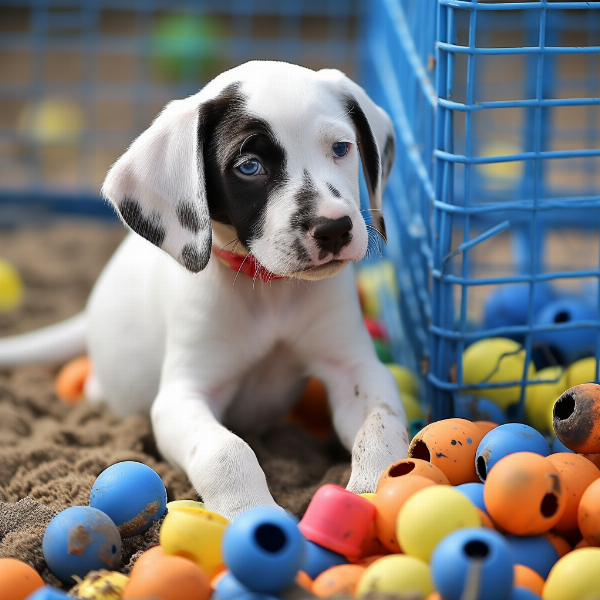
Staying Patient and Persistent in Your Efforts to Correct the Behavior
Correcting aggressive biting behavior in a 4-month-old puppy can be a challenging process that requires patience and persistence. It’s important to remember that behavior change takes time and that setbacks may occur. Here are some tips for staying patient and persistent in your efforts to correct your puppy’s behavior.
Stay Consistent
Consistency is key when correcting behavior in your puppy. Stick to the training plan, and be consistent in your approach to training. This will help your puppy understand what is expected of them and promote positive behavior.
Celebrate Small Wins
Celebrating small wins can help keep you motivated and reinforce positive behavior in your puppy. When your puppy exhibits positive behavior, such as playing gently or responding to a command, celebrate the accomplishment with verbal praise or a treat.
Take Breaks When Needed
Taking breaks when needed is important to prevent burnout and frustration. If you’re feeling overwhelmed or frustrated, take a break and return to training when you’re feeling more refreshed and focused.
Seek Support
Seeking support from family, friends, or a professional can help you stay motivated and on track with your training efforts. Support can come in the form of assistance with training exercises or simply providing encouragement.
Be Patient
Remember that behavior change takes time, and progress may not happen overnight. Be patient with your puppy and yourself, and don’t get discouraged if progress is slow. With patience and persistence, you can help your puppy develop positive behavior.
Correcting aggressive biting behavior in your 4-month-old puppy can be a challenging process, but staying patient and persistent can lead to positive results. By staying consistent, celebrating small wins, taking breaks when needed, seeking support, and being patient, you can help your puppy develop positive behavior and create a strong bond between you and your furry companion.
